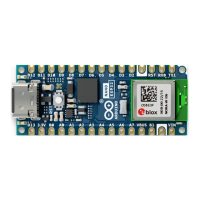5
5
5
5
6
7
7
8
8
8
8
9
9
9
9
10
10
10
11
11
11
11
12
12
12
13
13
13
13
13
14
15
15
16
Contents
1 The Board
1.1 Application Examples
2 ESP32 Core
3 Recommended Operating Conditions
4 Block Diagram
5 Board Topology
5.1 Front View
6 NORA-W106-10B (Radio Module / MCU)
6.1 Xtensa® Dual-Core 32bit LX7 Microprocessor
6.2 Wi-Fi®
6.3 Bluetooth®
7 System
7.1 Resets
7.2 Timers
7.3 Interrupts
8 Serial Communication Protocols
8.1 Inter-Integrated Circuit (I2C)
8.2 Inter-IC Sound (I2S)
8.3 Serial Peripheral Interface (SPI)
8.4 Universal Asynchronous Receiver/Transmitter (UART)
8.5 Two Wire Automotive Interface (TWAI®)
9 External Flash Memory
10 USB Connector
11 Power Options
11.1 Power Tree
11.2 Pin Voltage
11.3 VIN Rating
11.4 VUSB
11.5 Using the 3.3 V Pin
11.6 Pin Current
12 Pinout
12.1 Analog (JP1)
12.2 Digital (JP2)
13 Mounting Holes And Board Outline

